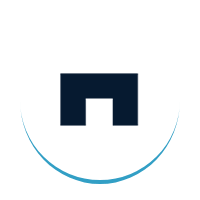Top 7 Full Stack Development Companies to Watch in 2026
Navigating the market for skilled software engineering can be a significant challenge, especially when your project demands expertise across the entire technology stack. Finding a single partner that can manage front-end user interfaces, back-end server logic, databases, and deployment infrastructure is crucial for streamlined development and cohesive product delivery. This guide is designed to simplify that search by showcasing the top full stack development companies and platforms available today. We provide a curated roundup to help you identify the ideal partner, whether you’re a startup building an MVP or an enterprise augmenting your internal team.
For CTOs and product leaders, selecting the right team means balancing technical proficiency, project management, and budget. Before committing, it’s prudent to weigh the broader advantages and disadvantages of outsourcing to ensure the model aligns with your strategic goals. Whether you need a comprehensive AI solutions partner or specialized custom software development, the options are vast. This article cuts through the noise, presenting each company with key service offerings, standout projects, and direct contact links to help you make an informed decision quickly and efficiently. We’ve structured this list to give you actionable insights, enabling you to compare vendors and find the perfect fit for your technical and business requirements.
Top 7 Full Stack Development Companies
1. Bridge Global
Bridge Global positions itself as a premier AI-first software partner, excelling at transforming ambitious ideas into secure, scalable, and intelligent digital products. With two decades of experience rooted in agile delivery, Bridge stands out among full stack development companies by deeply integrating AI across every stage of the software development lifecycle. This AI-driven approach is designed not as an afterthought, but as a core component to accelerate delivery, proactively mitigate risks, and elevate the quality of the final product.
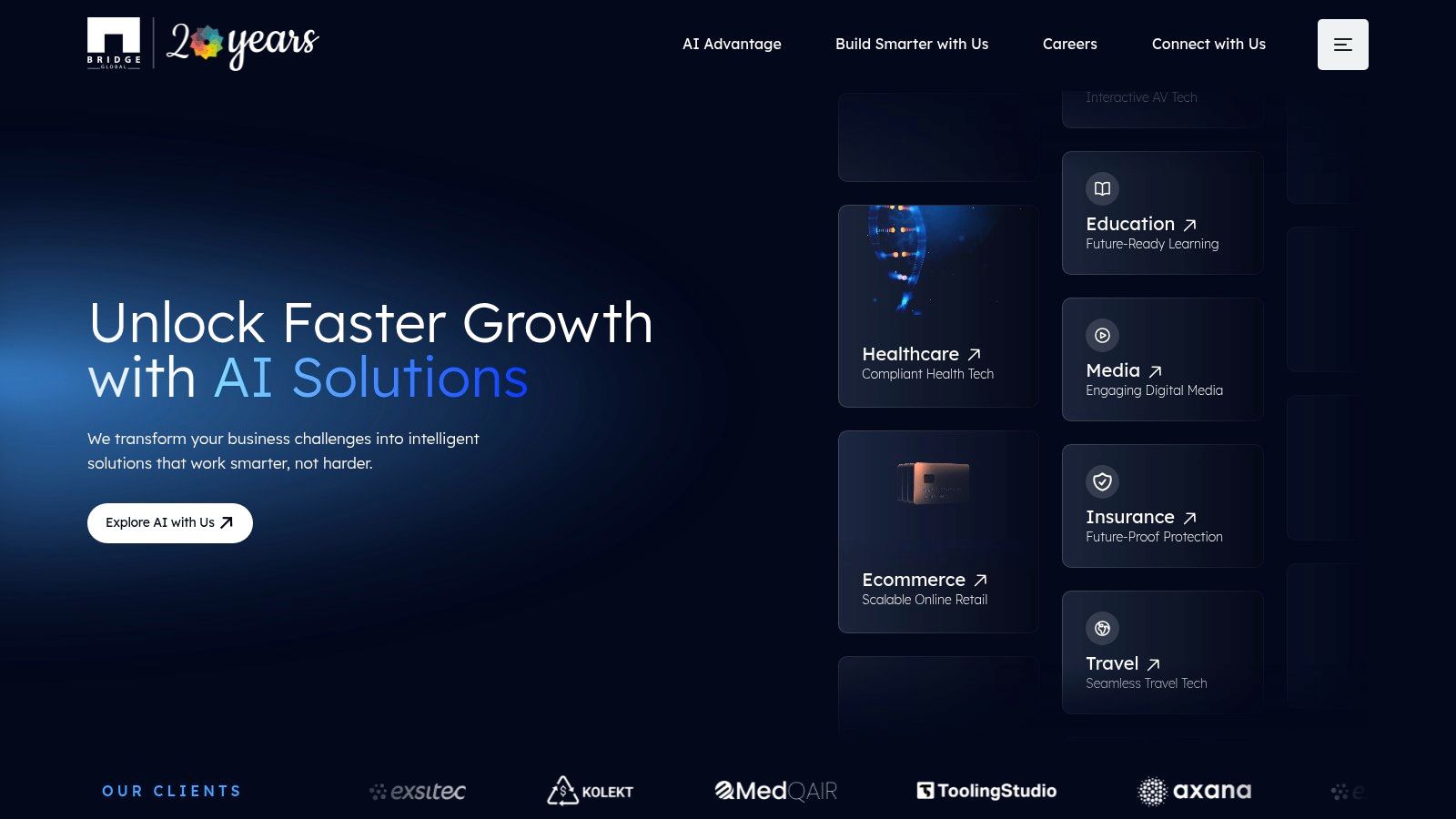
The company’s methodology is consultative and outcome-driven, beginning with comprehensive discovery workshops to align on goals. From there, Bridge Global provides tailored recommendations that lead to an AI-enhanced development process and ongoing support, ensuring solutions are not only launched successfully but are also future-ready. This strategic partnership model is particularly effective for CTOs and product leaders who need to augment their teams, build rapid MVPs, or scale their product engineering capabilities efficiently.
Key Strengths and Service Offerings
Bridge Global offers a robust suite of services that cater to both startups and established enterprises. Their offerings are built on a foundation of proven agile processes and a commitment to innovation.
- AI-Integrated Development: Bridge leverages AI to predict project risks, automate workflows, and enhance quality assurance. Their AI for your business framework ensures that generative AI, machine learning, and data science are core to the engineering process, not just ad-hoc additions.
- Full-Cycle Service Spectrum: The company provides end-to-end services, including custom software development, UI/UX design, cloud enablement, and IoT software development services. You can explore their full-stack capabilities to understand the depth of their technical expertise.
- Industry-Specific Compliance: Bridge demonstrates significant experience in highly regulated sectors like healthcare, finance, and insurance. Their work in healthcare software development highlights their ability to deliver secure and compliant solutions.
- Flexible Engagement Models: Clients can choose from full-cycle delivery, co-development partnerships, or dedicated AI transformation engagements. This flexibility allows businesses to get the precise support they need, whether for a startup MVP or an enterprise-wide modernization program.
Pricing and Best Fit
Bridge Global does not publish public pricing, opting for a custom-quoted model based on an initial discovery phase. This ensures each project is scoped accurately to the client’s specific needs and goals.
This approach makes Bridge Global an excellent choice for organizations seeking a true strategic AI solutions partner rather than a simple off-the-shelf vendor. It is ideally suited for:
- Startups needing expert guidance and rapid MVP development.
- Mid-market and enterprise teams focused on scaling operations, modernizing legacy systems, and embedding AI for a competitive advantage.
Website: https://www.bridge-global.com
2. Clutch
For businesses seeking a data-driven approach to finding and vetting partners, Clutch serves as an indispensable B2B research and review platform. It’s less a single company and more of a comprehensive, US-centric directory where you can find, compare, and connect with hundreds of full stack development companies. Its core value lies in its massive repository of verified, in-depth client reviews, which provide unparalleled transparency into a firm’s performance, communication, and project management capabilities.
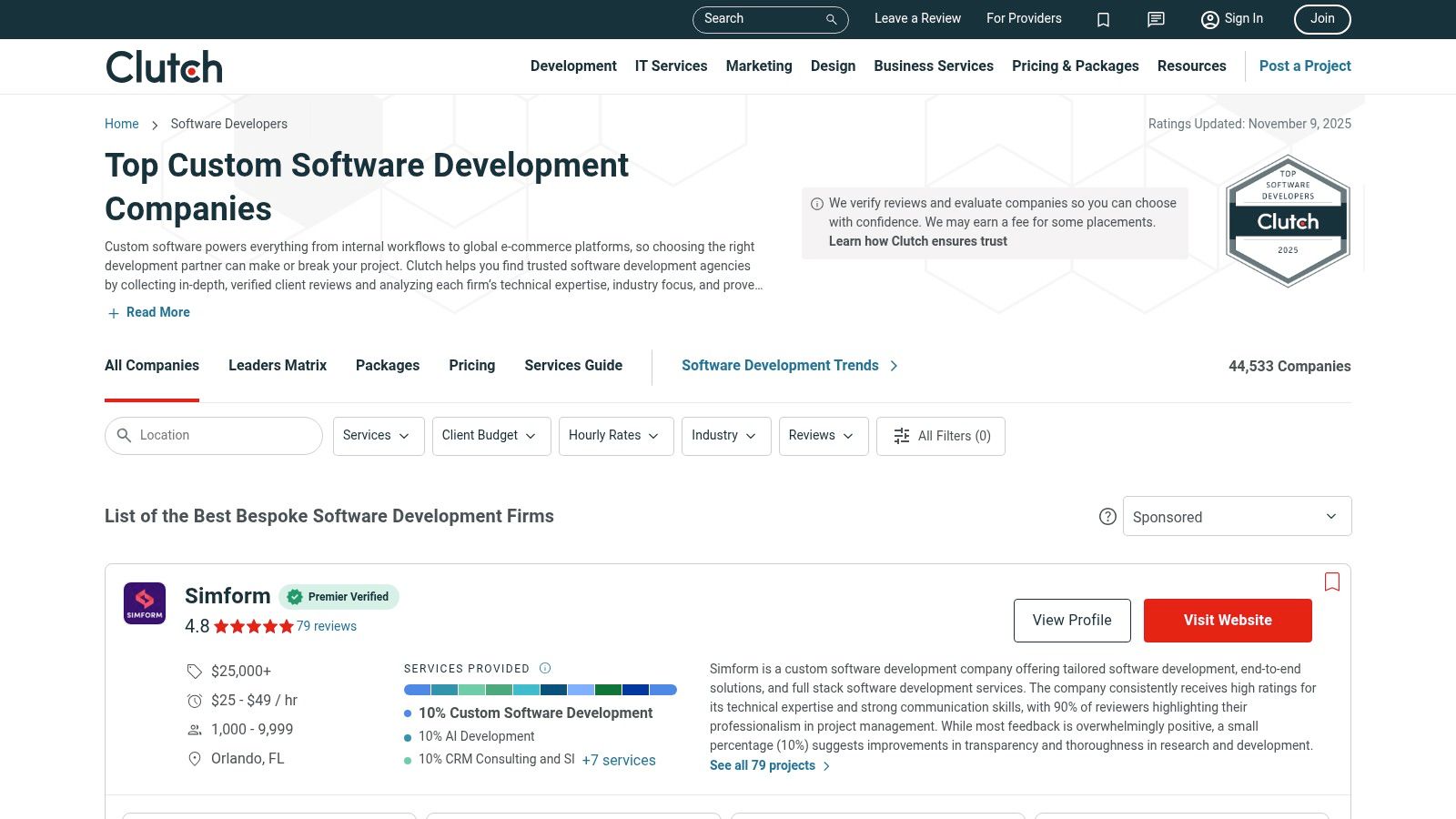
Unlike a direct agency website, Clutch empowers you to conduct market research efficiently. Its powerful filtering system allows you to shortlist vendors based on specific criteria, including technical expertise (e.g., Node.js, React, Python), budget, team size, and industry focus. Each company profile is a detailed dossier, featuring a portfolio of work, client testimonials, and service specializations, from custom software development to focused AI development services.
Key Features and How to Use Them
To get the most out of Clutch, leverage its unique tools for a streamlined vendor selection process.
- Leaders Matrix: This visual tool plots companies based on their “Ability to Deliver” and “Focus.” Use it to quickly identify market leaders in the full stack development space.
- Verified Reviews: Pay close attention to the detailed, interview-style reviews. They often reveal crucial insights about a company’s collaborative process and problem-solving skills that you won’t find in a standard case study.
- Advanced Filtering: Don’t just search by service. Drill down by hourly rate ($50-$99, $100-$149, etc.), project size, and specific client focus (e.g., small business vs. enterprise) to create a highly relevant shortlist.
- Direct Outreach: Once you’ve identified promising candidates, you can use the platform’s built-in tools to request proposals directly from their profile pages, simplifying the initial contact process.
Pros and Cons
| Pros | Cons |
|---|---|
| Extensive Verified Reviews: Unbiased, detailed client feedback. | Sponsored Placements: Promoted listings can overshadow others. |
| Powerful Comparison Tools: Easily compare firms side-by-side. | Vague Pricing: Profiles show rate bands, not exact project costs. |
| Direct Contact Feature: Streamlines the request for proposal process. | Overwhelming Volume: The sheer number of firms can be daunting. |
While pricing is often presented in ranges, requiring direct outreach for a precise quote, Clutch remains one of the most effective platforms for discovering and validating potential full stack development companies. Its data-centric model significantly reduces the risk and time associated with finding the right technical partner.
Website: https://clutch.co/developers
3. Upwork
For organizations that need to quickly source individual talent or small, agile teams, Upwork is a leading global work marketplace. It excels at connecting businesses with freelance full stack development companies and individual engineers for projects ranging from short-term sprints to long-term staff augmentation. Its primary value is providing direct access to a vast pool of vetted professionals, complete with transparent work histories and integrated project management tools.
Unlike traditional agencies, Upwork empowers you to build your own team on demand. You can post a job and receive proposals or proactively search for and invite specific talent to apply. The platform handles the entire engagement lifecycle, from initial contracts and secure payments through its escrow service to time tracking and dispute resolution, significantly simplifying the process of working with remote developers.
Key Features and How to Use Them
To effectively navigate Upwork, it’s crucial to use its built-in features to find and manage the right talent.
- Advanced Talent Search: Use detailed filters to narrow down candidates by technical skills (React, Node.js, etc.), hourly rate, location (e.g., US-only), spoken languages, and “Job Success Score” to find the most qualified developers.
- Transparent Work Histories: Scrutinize freelancer profiles for past client feedback, hours worked, and portfolio items. This data is invaluable for vetting a developer’s reliability and quality of work.
- Job Posting and Invitations: For a broad response, post a detailed job description. For a more targeted approach, use the search filters to identify top candidates and send them direct invitations to interview for your project.
- Built-in Safeguards: Rely on Upwork’s escrow system for fixed-price projects and its Work Diary for hourly contracts. These tools ensure that you only pay for work that has been verifiably completed.
Pros and Cons
| Pros | Cons |
|---|---|
| Fast Sourcing and Onboarding: Quickly find and hire talent. | Variable Quality: Requires careful vetting to find top performers. |
| Broad Price Spectrum: Access developers at various price points. | Platform-Optimized Profiles: Best profiles may not be the best talent. |
| Integrated Project Tools: Escrow, time tracking, and contracts. | Self-Managed Vetting: You are responsible for testing and interviewing. |
While Upwork requires a more hands-on approach to vetting compared to a managed agency, its speed, flexibility, and vast talent pool make it an exceptional resource for augmenting teams or tackling specific development tasks. It’s one of the most direct ways to find full stack development companies and individuals ready to start immediately.
Website: https://www.upwork.com/hire/full-stack-developers/
4. Toptal
For businesses prioritizing senior-level expertise, Toptal operates as an exclusive network of on-demand developers and delivery teams. It differentiates itself from open marketplaces by rigorously vetting talent, ensuring that clients connect only with the top tier of full stack development companies and professionals. Toptal is ideal for mission-critical projects where deep experience and immediate impact are non-negotiable, offering everything from single senior developers to fully managed squads.
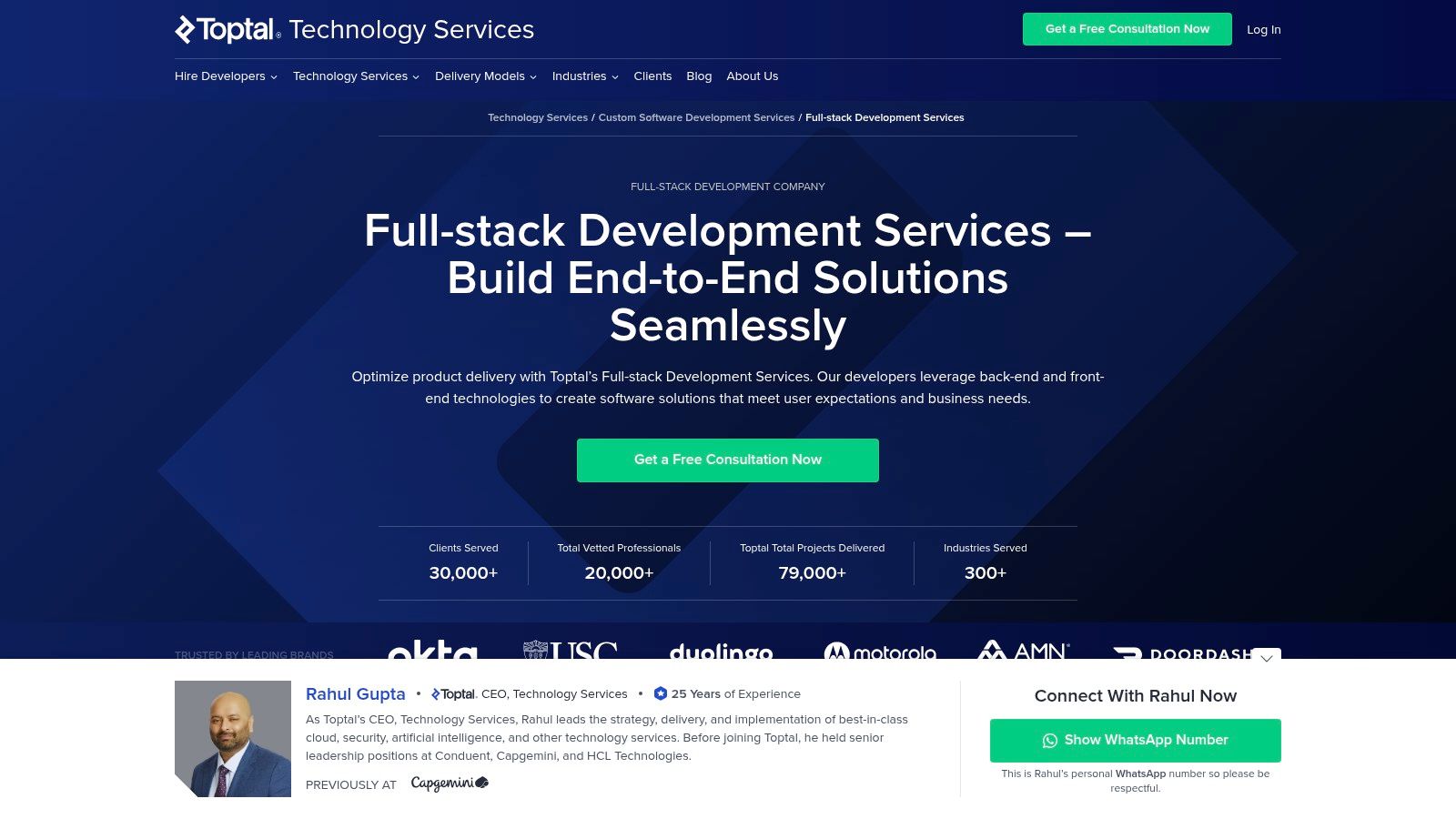
The platform’s core strength is its rapid matching process, which connects clients with suitable talent in as little as 48 hours. This accelerated timeline is a significant advantage for enterprises needing to augment their teams or launch new products without lengthy hiring cycles. Whether you need custom software development expertise or specialized AI development services, Toptal provides flexible engagement models to fit your project’s scale and management needs.
Key Features and How to Use Them
To make the most of Toptal’s premium network, focus on its structured engagement and talent-sourcing features.
- Rigorous Vetting Process: Trust in Toptal’s 5-step screening process, which evaluates language, skill, and real-world project work. This pre-vetting saves you significant time and resources in technical assessments.
- Flexible Engagement Models: Start with a free consultation to define your needs. Choose from staff augmentation, on-demand expert teams, or fully managed project delivery where Toptal oversees the entire development lifecycle.
- Rapid Matching: Clearly articulate your technical requirements, project scope, and team dynamics during the intake process. The more specific you are, the faster and more accurately their matching experts can find the right full stack developer or team.
- Scale On-Demand: Use the platform to seamlessly scale your team from a single senior developer for a specific task to a complete, managed full stack squad as your project evolves.
Pros and Cons
| Pros | Cons |
|---|---|
| Access to Elite Senior Talent: Connect with the top 3% of developers. | Premium Pricing: Costs are higher than open freelance marketplaces. |
| Fast Hiring Process: Matches are typically made within 48 hours. | Less Suited for Small Budgets: Not ideal for micro-tasks or minor projects. |
| Enterprise-Grade Service: Ideal for mission-critical, complex builds. | Focus on Individuals/Teams: Less of a traditional agency model. |
While Toptal comes at a premium price point, its value lies in providing high-caliber, vetted talent on an accelerated timeline. It remains a top choice for organizations seeking reliable full stack development companies and professionals to drive critical technology initiatives without the risks of an open market.
Website: https://www.toptal.com/services/technology-services/full-stack-development-services
5. Fiverr (Full‑Stack Web category)
For projects with well-defined scopes, such as building an MVP, adding a specific feature, or tackling a bug, Fiverr offers a massive marketplace of freelance talent. Its dedicated “Full-Stack Web” category connects businesses directly with individual developers and small studios, making it a powerful resource for finding specialized full stack development companies on a project basis. The platform’s core strength lies in its gig-based, fixed-price model, which provides upfront cost clarity and rapid turnaround times.
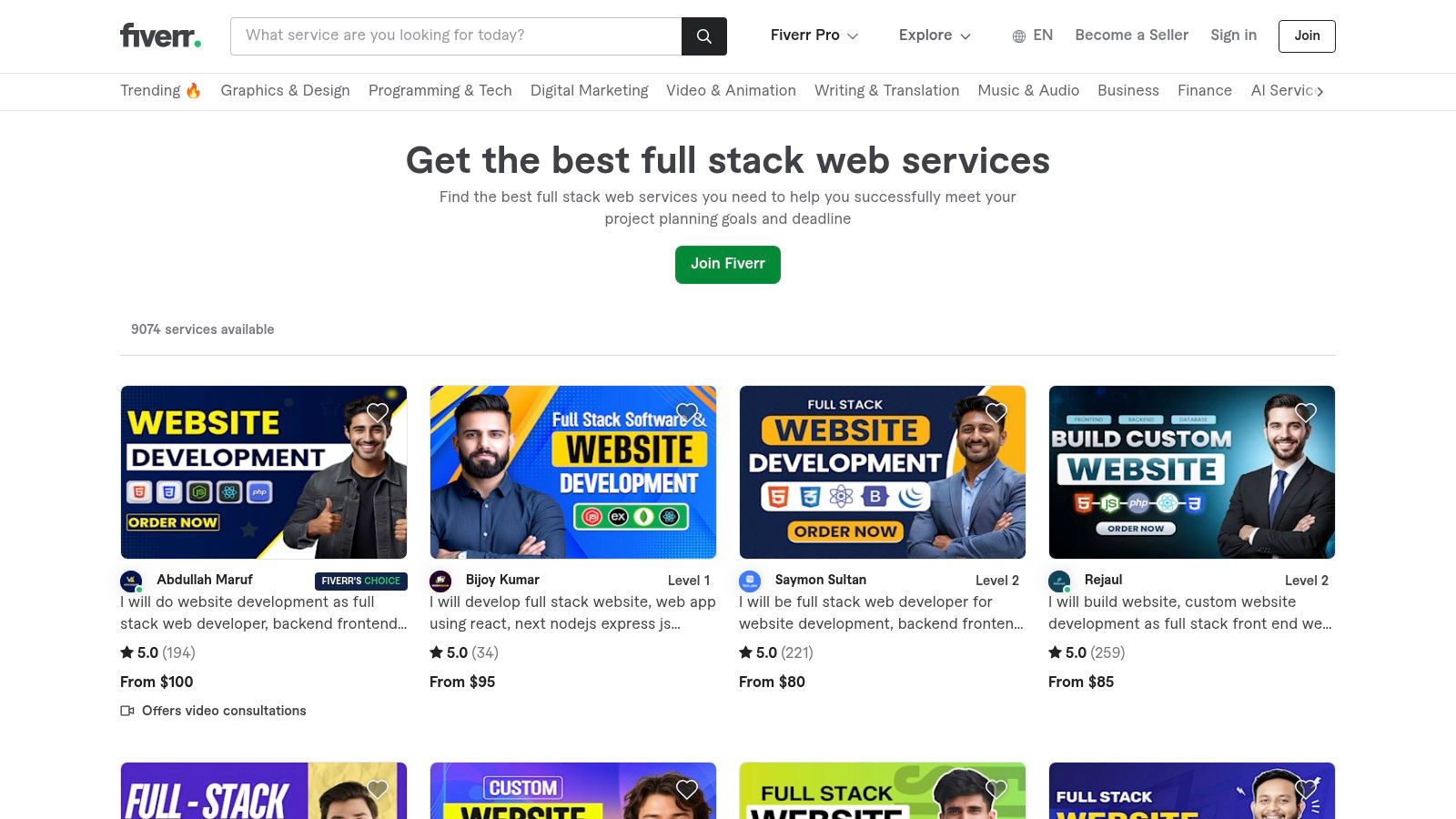
Unlike traditional agencies, Fiverr excels at transactional, clearly defined tasks. You can browse thousands of “gigs,” each a pre-packaged service with a set price, scope, and delivery time. This structure is ideal for augmenting an existing team or outsourcing specific components of a larger project, from custom software development tasks to smaller integrations. The platform’s vast talent pool means you can find developers with expertise in nearly any technology stack, including MERN, LAMP, Django, and more.
Key Features and How to Use Them
To effectively navigate Fiverr and find the right developer, focus on leveraging its built-in vetting and project management tools.
- Fixed-Price Packages: Gigs are typically offered in Basic, Standard, and Premium tiers. Carefully review what each tier includes, paying close attention to the number of revisions, delivery time, and scope of work to avoid scope creep.
- Ratings and Reviews: This is your primary tool for due diligence. Look for sellers with a high number of positive reviews and read the detailed feedback from previous buyers to understand their communication style, quality of work, and reliability.
- Upfront Portfolio and Profile: Before purchasing, thoroughly examine a seller’s portfolio and profile description. This will give you a clear sense of their technical skills and the types of projects they specialize in.
- In-Platform Milestones and Payments: Use Fiverr’s system for all communication and payments. This protects both parties and allows you to set milestones for larger projects, releasing payment only when each stage is completed to your satisfaction.
Pros and Cons
| Pros | Cons |
|---|---|
| Clear, Packaged Pricing: Upfront costs for small to medium tasks. | Quality Varies: Careful vetting and due diligence are essential. |
| Massive Supply: High probability of finding stack specialists. | Not for Complex Projects: Gig-style workflow may not suit long-term needs. |
| Fast Engagement: Quickly hire developers for urgent needs. | Communication Gaps: Time zone and language differences can be a challenge. |
Fiverr’s model is not designed for long-term, complex product development but shines for businesses needing speed, cost-effectiveness, and specific skills for a defined task. By carefully scoping your requirements and thoroughly vetting potential sellers, you can leverage it as a highly efficient tool for engaging with skilled full stack development companies and freelancers.
Website: https://www.fiverr.com/gigs/full-stack-web
6. GoodFirms
For companies looking to triangulate their vendor research, GoodFirms offers another robust B2B directory and review platform. Similar to its competitors, this US-based site provides a comprehensive catalog where businesses can discover, evaluate, and connect with a vast array of full stack development companies. Its primary strength lies in its extensive list of verified client feedback and transparent company profiles, serving as an excellent complementary resource for cross-referencing potential partners.
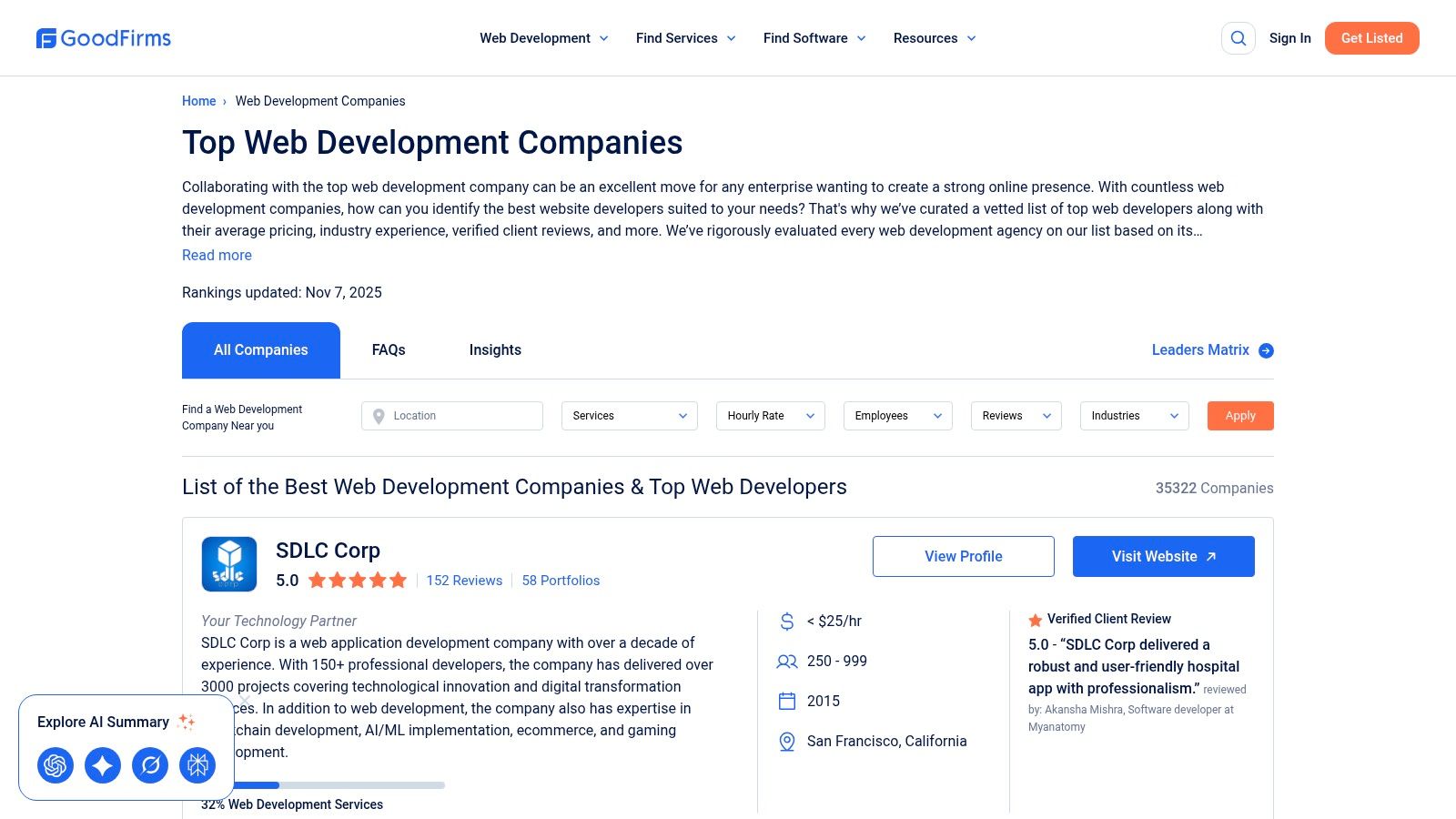
GoodFirms differentiates itself by providing a clean, user-friendly interface that simplifies the initial search process. Its filtering capabilities allow you to quickly narrow down choices by location, hourly rate, and industry focus, making it particularly useful for identifying candidates that fit specific regional or budgetary requirements. Each profile acts as a central hub for information, detailing a company’s service lines, from custom software development to specialized cloud services, alongside their portfolio and client reviews.
Key Features and How to Use Them
To effectively use GoodFirms for your search, focus on its core filtering and verification features.
- Regional and Budget Filtering: Start by filtering potential firms by country (e.g., US, UK, India) and hourly rate bands. This is one of the fastest ways to build a shortlist of financially and logistically viable candidates.
- Industry Specialization: Use the industry focus filter to find developers with proven experience in your sector, whether it’s healthcare software development or finance. This ensures they understand your unique compliance and market needs.
- Verified Reviews: Scrutinize the client reviews for patterns in project management style, technical proficiency, and communication. This firsthand feedback provides insights you won’t find on a company’s marketing site.
- Cross-Reference Shortlists: Use GoodFirms in conjunction with other platforms. If you identify a promising company on another site, search for their GoodFirms profile to gather additional reviews and data points for a more complete picture.
Pros and Cons
| Pros | Cons |
|---|---|
| High-Signal Directory: Excellent for triangulating shortlists. | Vague Service Breakdowns: Not all firms list granular full stack skills. |
| Strong Regional & Budget Filters: Quickly find region- and budget-fit candidates. | Sponsored Listings: Promoted profiles can influence search order. |
| Large, Updated Catalog: A wide selection of web and software firms. | Follow-up Required: May need direct outreach for specific tech stack details. |
While some profiles may require direct contact to confirm specific full stack capabilities, GoodFirms is a highly effective tool for initial discovery and secondary verification. It excels at helping businesses quickly surface potential full stack development companies that align with key logistical and financial constraints, making it an invaluable part of a comprehensive vetting process.
Website: https://www.goodfirms.co/companies/web-development-agency
7. AWS Partners and AWS Marketplace (Application Development)
For organizations building on Amazon Web Services, the AWS Partner Network and Marketplace offer a direct channel to find vetted consulting partners specializing in full-stack application development. This ecosystem is not a single company but a curated directory of full stack development companies that have proven expertise and certifications in the AWS environment. Its primary advantage is streamlining the procurement and delivery of cloud-native projects by connecting you with partners who deeply understand the AWS stack.
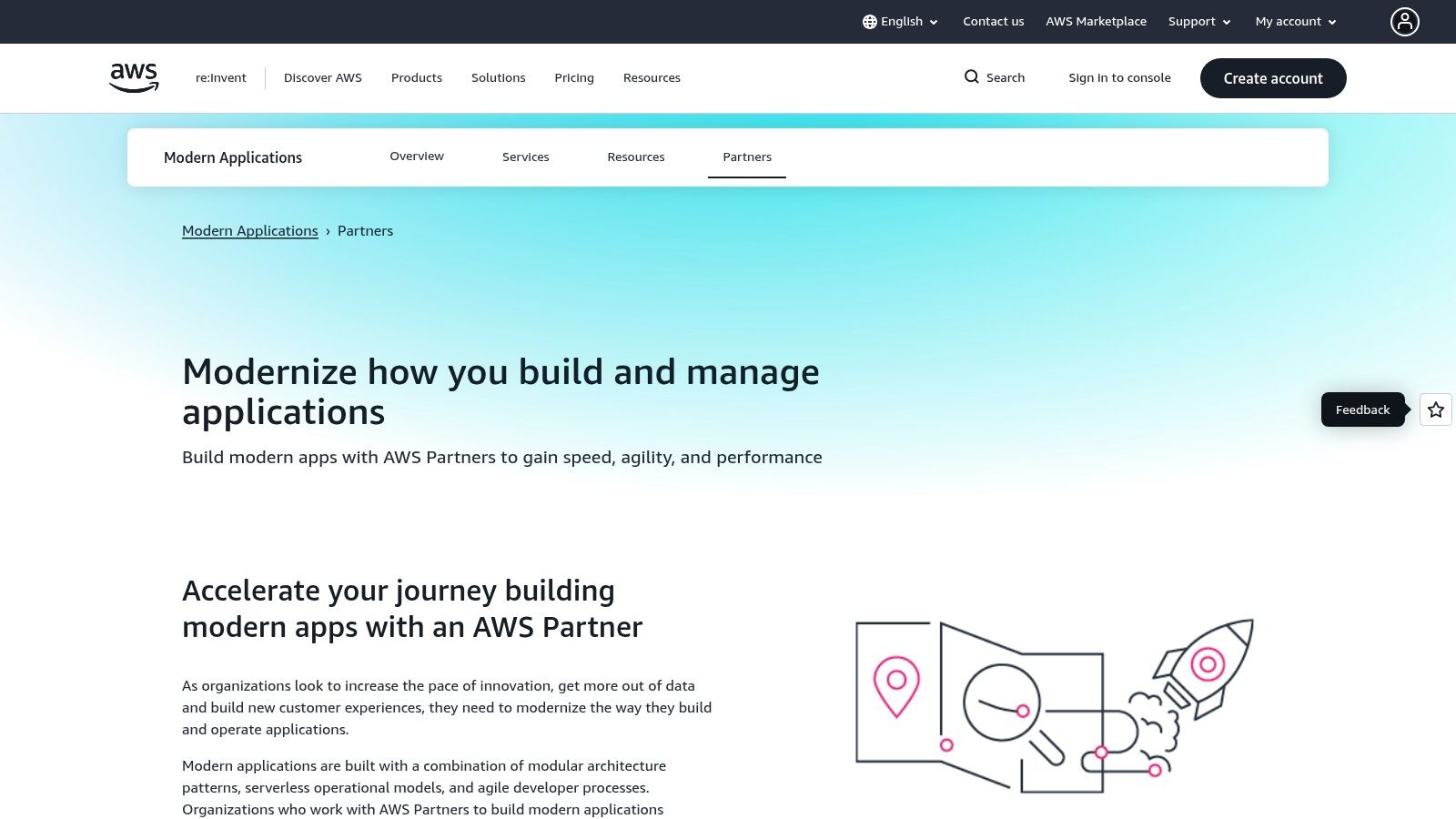
Unlike generic directories, the AWS platform is designed for technical alignment. It allows you to find partners with specific competencies, such as Node.js, React, or .NET on AWS, ensuring they have the right skills for your project. Many partners listed offer discovery workshops, on-demand architectural guidance, and defined project scopes. A key differentiator is the option to transact directly through the AWS Marketplace, centralizing procurement and simplifying invoicing for businesses already using AWS for their cloud services.
Key Features and How to Use Them
To effectively navigate this platform, focus on its built-in tools for partner discovery and engagement.
- Find a Partner Tool: Use this feature to filter partners by competency (e.g., DevOps, Application Development), location, and specific AWS services. This helps you narrow down the vast network to the most relevant experts.
- Marketplace Consulting Offers: Look for partners offering “Consulting Services” on the AWS Marketplace. These often have clearly defined capabilities, listed skills, and sometimes even fixed-price discovery workshops to start the engagement.
- AWS Competency Programs: Prioritize partners who have achieved an AWS Competency. This signifies that AWS has technically vetted and validated their expertise and proven customer success in a specific area.
- Transact Through AWS: For simplified procurement, look for partners offering “Seller Private Offers.” This allows you to purchase their services through your existing AWS account, consolidating billing and streamlining compliance.
Pros and Cons
| Pros | Cons |
|---|---|
| Strong Fit for AWS Projects: Ideal for cloud-native modernization. | AWS-Centric Focus: Less relevant if your stack is not on AWS. |
| Procurement Convenience: Centralized billing via AWS channels. | Opaque Pricing: Often requires a scoping call for a precise quote. |
| Vetted Partner Expertise: Partners are certified and validated by AWS. | Partner Variability: Quality and process can vary between partners. |
While pricing often requires direct engagement for a detailed quote, the AWS Partner ecosystem provides unparalleled value for businesses committed to the AWS cloud. It reduces the risk of hiring a mismatched team and aligns your development efforts with cloud-native best practices, making it an essential resource for finding qualified full stack development companies.
Website: https://aws.amazon.com/modern-apps/partners/
Top 7 Full-Stack Development Companies Comparison
| Provider | Implementation complexity | Resource requirements | Expected outcomes | Ideal use cases | Key advantages |
|---|---|---|---|---|---|
| Bridge Global | Medium–High — full‑cycle, AI‑integrated delivery | Custom scoped cross‑functional teams; workshop + discovery required | AI‑enabled, secure, scalable products; faster delivery and improved quality | Startups needing rapid MVPs; mid‑market/enterprise modernization and regulated industries | AI baked into SDLC, compliance expertise, proven agile delivery |
| Clutch | Low — directory/search-driven selection | Time for research, shortlist review and outreach | Shortlist of agencies with verified reviews and pricing bands | Vendor comparison and RFP shortlisting for agency selection | Large volume of verified reviews, deep filtering and comparison tools |
| Upwork | Low — fast marketplace hiring | Internal vetting, possible paid tests; variable budgets | Rapid staffing or short‑term aug; flexible hourly/fixed hires | Short sprints, staff augmentation, flexible capacity needs | Fast sourcing, broad price range, platform tools (escrow, tracking) |
| Toptal | Medium — curated matching and managed engagements | Higher budget; preference for senior, vetted talent | Senior‑led delivery or managed squads with predictable outcomes | Mission‑critical builds needing senior expertise or managed teams | Rigorous vetting, enterprise‑grade process, managed delivery options |
| Fiverr (Full‑Stack) | Low — gig‑style, fixed‑price engagements | Low to moderate budget per gig; careful scoping required | Packaged deliverables and quick turnarounds for scoped tasks | Scoped features, small MVP components, one‑off tasks | Clear fixed pricing, fast engagement, large specialist supply |
| GoodFirms | Low — complementary directory research | Time to compare and triangulate with other sources | Additional vendor options and regional/budget matches | Triangulating shortlists alongside Clutch and other directories | Useful regional/budget filters and verified client feedback |
| AWS Partners / Marketplace | Medium–High — cloud‑aligned partner engagements | AWS‑aligned expertise, certifications; procurement via AWS possible | Cloud‑native or modernized apps optimized for AWS; easier billing | Projects built on AWS or requiring centralized procurement/compliance | AWS certification alignment, marketplace procurement and seller offers |
Making Your Final Choice: Partnering for Future Growth
Navigating the landscape of full stack development companies can feel complex, but this guide has equipped you with a diverse range of options, from dedicated development partners like Bridge Global to expansive freelance platforms and curated directories. We’ve explored how agencies offer end-to-end project management, while platforms like Upwork and Toptal provide access to a global talent pool for specific, targeted needs. The key takeaway is that the “best” choice is entirely dependent on your unique project requirements, long-term goals, and internal capacity.
A startup racing to launch an MVP will have vastly different needs than an enterprise organization looking to implement a secure, scalable AI solution. While one may prioritize speed and cost-effectiveness from a freelance marketplace, the other requires a strategic partnership that offers deep domain expertise, robust security protocols, and comprehensive support. Your decision hinges on understanding this fundamental difference.
Actionable Steps to Selecting Your Partner
Before you make contact, take a moment to solidify your internal strategy. This preparation will streamline the selection process and ensure you find a partner who can truly deliver on your vision.
- Define Your Project Scope and Core Needs: Clearly document your technical requirements, desired outcomes, and key performance indicators (KPIs). Are you building a new application from scratch, requiring custom software development, or are you looking to integrate advanced analytics through business intelligence services? A well-defined scope is your most powerful tool.
- Evaluate Your Internal Expertise: Be realistic about your team’s current skill set. Do you need a partner to augment your existing team, or are you looking for a fully outsourced development team to handle everything? This will help you decide between hiring individual freelancers and engaging a comprehensive AI solutions partner.
- Assess Technical and Cultural Fit: Beyond a company’s portfolio, consider their communication style, project management methodologies, and overall company culture. A successful partnership relies on seamless collaboration. Review their client cases to see if they have experience with organizations like yours, whether it’s in healthcare software development or building Custom Ecommerce Solutions.
- Plan for the Future: Your immediate project is just one piece of a larger puzzle. Think about your long-term roadmap. Will you need ongoing maintenance, scalability through cloud services, or future integration of emerging technologies? Choosing a partner who can grow with you is a strategic advantage, especially if you plan to explore how to leverage AI for your business down the line.
Ultimately, selecting from the best full stack development companies is about more than just hiring coders; it’s about forging a strategic partnership that drives innovation and secures your competitive edge. By carefully evaluating your needs against the distinct offerings of agencies, platforms, and marketplaces, you can confidently choose a partner poised to turn your vision into a reality and support your growth for years to come.
Frequently Asked Questions (FAQ)
What is a full stack development company?
A full stack development company provides end-to-end software development services, covering all aspects of an application’s technology stack. This includes front-end (user interface), back-end (server-side logic), database management, and DevOps (deployment and infrastructure). Hiring one means you get a single, cohesive team that can build and maintain an entire product from start to finish.
Why should I hire a full stack development company instead of individual freelancers?
Hiring a full stack development company offers several advantages, including streamlined project management, a single point of accountability, and a team of specialists (UI/UX designers, QA testers, project managers) working in sync. This integrated approach often leads to higher quality, faster delivery, and better long-term scalability compared to coordinating multiple individual freelancers.
What should I look for when choosing a full stack development partner?
Look for a company with a strong portfolio of projects similar to yours, positive client reviews, and expertise in your required technology stack. It’s also critical to assess their communication processes, project management methodologies (e.g., Agile, Scrum), and cultural fit to ensure a smooth collaboration.
How much does it cost to hire a full stack development company?
Costs can vary significantly based on the company’s location, the project’s complexity, the team’s size, and the engagement model. Rates can range from $50 to over $200 per hour. It’s best to request a custom quote based on a detailed project scope. Some companies, like Bridge Global, offer an initial discovery phase to provide an accurate estimate.
When your project demands a dedicated team with deep expertise across the entire technology stack, Bridge Global stands ready to be your strategic partner. As a leader among full stack development companies, we specialize in everything from custom software and AI development to scalable cloud solutions. Explore how our tailored approach can accelerate your digital transformation.
